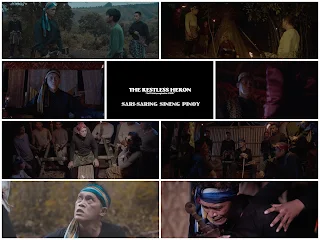Alan Filoteo's The Restless Heron (Filcor Multimedia Studio, Cronasia Foundation College, 2022) succeeds in its loftier ambition of taking such a story and placing it within a cinematic tradition that makes it much bigger than itself, as big, in fact, as the landscape it inhabits which is as beautiful and as vast as man’s capacity for cruelty. There’s an aura of despair, a sense that they’ve already been rejected and dehumanized. Nature looms large along with an almost claustrophobic idea of community that spills over into oppression in the village at the center of the story. The Restless Heron is a film about outsiders. There’s the literal kind, like Datu Ali (Jun Nayra), who lives outside society’s rules. Then there are those who are kept out by design. This and other tensions underlie the film’s narrative, though Filoteo prefers the observational approach - piercing the atmosphere with personalities who contribute to a sophisticated dynamic. The movie hits a snag with its sluggish finale nevertheless, it’s revealing to watch the entire cast attempt to answer questions about the nature of their conundrum. The Restless Heron takes its historical setting and uses it to explore contemporary concerns of the individual and society.
The Sultan of Talik, whether literally placed center screen, or taking the privileged vantage point where he is the only character who sees the whole action unfold. Rolando Inocencio's air of contemplative patience makes him a magnetic figure, while the distinctive rhythms and inflections of his speaking style is one of this actor’s mesmerizing features. Nayra offers a standout performance conveying Datu Ali's rage at society with depth and deftness. Filoteo understands that oppression creates tension, and tension creates a story. Each character is clearly defined, as are their motives giving the film its soul. The Restless Heron benefits from exceptional performances from the whole ensemble. The staid tone can feel monotonous after a certain point, and the film never picks up the pace or mood enough to break from its shell of strife and persecution.The dismissal of traditional tropes is perhaps its most effective feature, it also gives rise to the film’s most disappointing aspect. The moments don’t always live up to their own hype. For many scenes, the journey is far better than the destination. Despite its best efforts, The Restless Heron drifts into a mode of exocitism that renders an ultimately frustrating experience.
Director of Photography: Yen Morales
Sound Mixer: Jaylou Garban Dari
Art Director: Marthin Anthony Lozano Millado
Screenwriters: Ivy Masque, Alyanna Lumaguinding, Jan Ardis Limjap
Music License: Artlist
Directed By: Alan Filoteo










